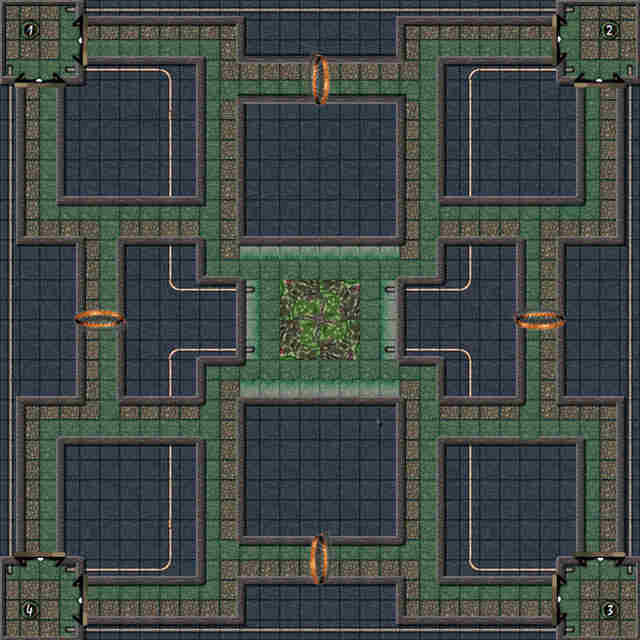
A1 A2 A3 A4 B1 B2 B3 B4 C1 C2 C3 C4 D1 D2 D3 D4 E1 E2 E3 E4 F1 F2 F3 F4 G1 G2 G3 G4 H1 H2 H3 H4 I1 I2 I3 I4 T1T2Movement from last Pin:
Description:
- Starting Boxes: Characters start in one of the four starting boxes in the corners of the map, rolled randomly.
- Sewer Ceiling: The ceiling is at 10 feet. Huge and bigger creatures have to squeeze all the time.
- The Water: The murky green water is 1ft deep and counts as difficult terrain. Since large creatures use up four squares, they are always affected by the water.
- The Sludge: In the center is a 4-foot deep pool of sludge. It counts as Deep Bog (medium and larger PCs need 4 squares of movement per square; small PCs must swim (DC 10); Move Silently DC+2; provides cover; see DMG p. 88) and because of its toxic nature deals 2d6 acid damage per round to anyone standing in such a square.
- The Grates: The four grates block the path of the sewer tunnels. However, the 5 bars are slightly bent so that there are ways to get through:
- Squeeze: A small character can squeeze through. A medium character needs a DC 20 Escape Artist check while larger creatures cannot squeeze through in that way.
- Bent Bars: You can bent the bars with a DC 24 Strength check. Each successful check makes you one size category smaller for purposes of squeezing through.
- Destroy Bars: You can sunder the bars. They have AC 5, Hardness 10 and 10 hit points each. For every two destroyed bars, you are considered one size category smaller for purposes of squeezing through. If all 5 bars are gone, the grate is no obstacle anymore for the rest of the encounter.
- Other Options: Of course, you can always teleport to the other side, use things like gaseous form or incorporeality to pass.
- The Pipes: The sewer pipes carry noise. In effect, this means that two squares with pipe exits are considered to be adjacent for listen check purposes. This only works directly; you cannot for example use two pipes to negate distance penalties. Pipes do not establish LOS nor can they be entered (they're closed and filled with ...stuff).
- Terrain Type: The sewer counts as Indoor, Underground, and City terrain. The ground is worked stone.
Circle: Square:
Opacity: (range 1-100)
Edit Link:

Informations:
- Fill the Name of your gladiators in the Characters section
- Click the P(ick) button near pin 1 and put it on the map for the starting position
- Click the P(ick) button near pin 2 (and 3 and 4 if needed) and put it on the map for moving position
- Repeat this for all your characters
- Optionally fill the Note for your character
- Click the Generate button, this loads the image and copy the IMG tag in your clipboard
- Use C(ancel) button to remove a pin from the map